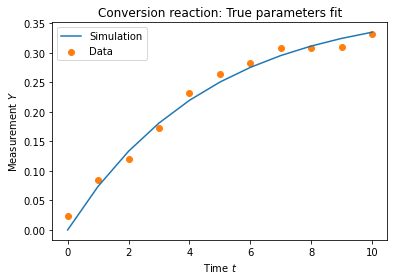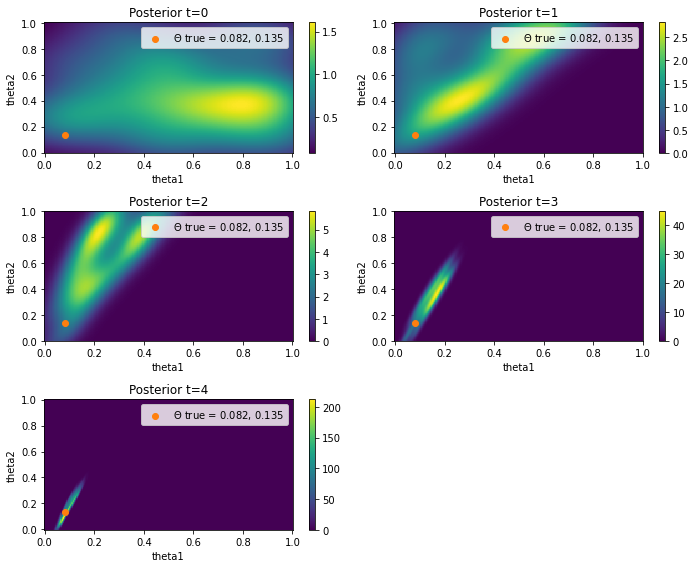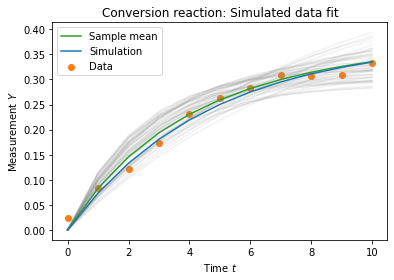Ordinary differential equations: Conversion reaction
This example was kindly contributed by Lukas Sandmeir and Elba Raimundez. It can be downloaded here:
Ordinary Differential Equations.
Note: Before you use pyABC to parametrize your ODE, please be aware of potential errors introduced by inadequately representing the data generation process, see also the “Measurement noise assessment” notebook. For deterministic models, there are often more efficient alternatives to ABC, check out for example our tool pyPESTO.
This example provides a model for the interconversion of two species (\(X_1\) and \(X_2\)) following first-order mass action kinetics with the parameters \(\Theta_1\) and \(\Theta_2\) respectively:
Measurement of \([X_2]\) is provided as \(Y = [X_2]\).
We will show how to estimate \(\Theta_1\) and \(\Theta_2\) using pyABC.
[1]:
# install if not done yet
!pip install pyabc --quiet
[2]:
%matplotlib inline
import os
import tempfile
import matplotlib.pyplot as plt
import numpy as np
import scipy as sp
from pyabc import ABCSMC, RV, Distribution, LocalTransition, MedianEpsilon
from pyabc.visualization import plot_data_callback, plot_kde_2d
db_path = "sqlite:///" + os.path.join(tempfile.gettempdir(), "test.db")
Data
We use an artificial data set which consists of a vector of time points \(t\) and a measurement vector \(Y\). This data was created using the parameter values which are assigned to \(\Theta_{\text{true}}\) and by adding normaly distributed measurement noise with variance \(\sigma^2 = 0.015^2\).
ODE model
Define the true parameters
[3]:
theta1_true, theta2_true = np.exp([-2.5, -2])
and the measurement data
[4]:
measurement_data = np.array(
[
0.0244,
0.0842,
0.1208,
0.1724,
0.2315,
0.2634,
0.2831,
0.3084,
0.3079,
0.3097,
0.3324,
]
)
as well as the time points at whith to evaluate
[5]:
measurement_times = np.arange(len(measurement_data))
and the initial conditions for \(X_1\) and \(X_2\)
[6]:
init = np.array([1, 0])
Define the ODE model
[7]:
def f(y, t0, theta1, theta2):
x1, x2 = y
dx1 = -theta1 * x1 + theta2 * x2
dx2 = theta1 * x1 - theta2 * x2
return dx1, dx2
def model(pars):
sol = sp.integrate.odeint(
f, init, measurement_times, args=(pars["theta1"], pars["theta2"])
)
return {"X_2": sol[:, 1]}
Integration of the ODE model for the true parameter values
[8]:
true_trajectory = model({"theta1": theta1_true, "theta2": theta2_true})["X_2"]
Let’s visualize the results
[9]:
plt.plot(true_trajectory, color="C0", label='Simulation')
plt.scatter(measurement_times, measurement_data, color="C1", label='Data')
plt.xlabel('Time $t$')
plt.ylabel('Measurement $Y$')
plt.title('Conversion reaction: True parameters fit')
plt.legend()
plt.show()

[10]:
def distance(simulation, data):
return np.absolute(data["X_2"] - simulation["X_2"]).sum()
Define the prior for \(\Theta_1\) and \(\Theta_2\)
[11]:
parameter_prior = Distribution(
theta1=RV("uniform", 0, 1), theta2=RV("uniform", 0, 1)
)
parameter_prior.get_parameter_names()
[11]:
['theta1', 'theta2']
[12]:
abc = ABCSMC(
models=model,
parameter_priors=parameter_prior,
distance_function=distance,
population_size=50,
transitions=LocalTransition(k_fraction=0.3),
eps=MedianEpsilon(500, median_multiplier=0.7),
)
ABC.Sampler INFO: Parallelize sampling on 4 processes.
[13]:
abc.new(db_path, {"X_2": measurement_data});
ABC.History INFO: Start <ABCSMC id=4, start_time=2021-11-18 17:40:36>
[14]:
h = abc.run(minimum_epsilon=0.1, max_nr_populations=5)
ABC INFO: t: 0, eps: 5.00000000e+02.
ABC INFO: Accepted: 50 / 53 = 9.4340e-01, ESS: 5.0000e+01.
ABC INFO: t: 1, eps: 1.89305859e+00.
ABC INFO: Accepted: 50 / 164 = 3.0488e-01, ESS: 4.4195e+01.
ABC INFO: t: 2, eps: 9.64400074e-01.
ABC INFO: Accepted: 50 / 159 = 3.1447e-01, ESS: 3.7093e+01.
ABC INFO: t: 3, eps: 4.96905744e-01.
ABC INFO: Accepted: 50 / 329 = 1.5198e-01, ESS: 3.5372e+01.
ABC INFO: t: 4, eps: 2.94398923e-01.
ABC INFO: Accepted: 50 / 448 = 1.1161e-01, ESS: 4.4592e+01.
ABC INFO: Stop: Maximum number of generations.
ABC.History INFO: Done <ABCSMC id=4, duration=0:00:03.032233, end_time=2021-11-18 17:40:39>
Visualization of the probability density functions for \(\Theta_1\) and \(\Theta_2\)
[15]:
fig = plt.figure(figsize=(10, 8))
for t in range(h.max_t + 1):
ax = fig.add_subplot(3, int(np.ceil(h.max_t / 3)), t + 1)
ax = plot_kde_2d(
*h.get_distribution(m=0, t=t),
"theta1",
"theta2",
xmin=0,
xmax=1,
numx=200,
ymin=0,
ymax=1,
numy=200,
ax=ax,
)
ax.scatter(
[theta1_true],
[theta2_true],
color="C1",
label=r'$\Theta$ true = {:.3f}, {:.3f}'.format(
theta1_true, theta2_true
),
)
ax.set_title(f"Posterior t={t}")
ax.legend()
fig.tight_layout()

We can also plot the simulated trajectories:
[16]:
_, ax = plt.subplots()
def plot_data(sum_stat, weight, ax, **kwargs):
"""Plot a single trajectory"""
ax.plot(measurement_times, sum_stat['X_2'], color='grey', alpha=0.1)
def plot_mean(sum_stats, weights, ax, **kwargs):
"""Plot mean over all samples"""
weights = np.array(weights)
weights /= weights.sum()
data = np.array([sum_stat['X_2'] for sum_stat in sum_stats])
mean = (data * weights.reshape((-1, 1))).sum(axis=0)
ax.plot(measurement_times, mean, color='C2', label='Sample mean')
ax = plot_data_callback(h, plot_data, plot_mean, ax=ax)
plt.plot(true_trajectory, color="C0", label='Simulation')
plt.scatter(measurement_times, measurement_data, color="C1", label='Data')
plt.xlabel('Time $t$')
plt.ylabel('Measurement $Y$')
plt.title('Conversion reaction: Simulated data fit')
plt.legend()
plt.show()
